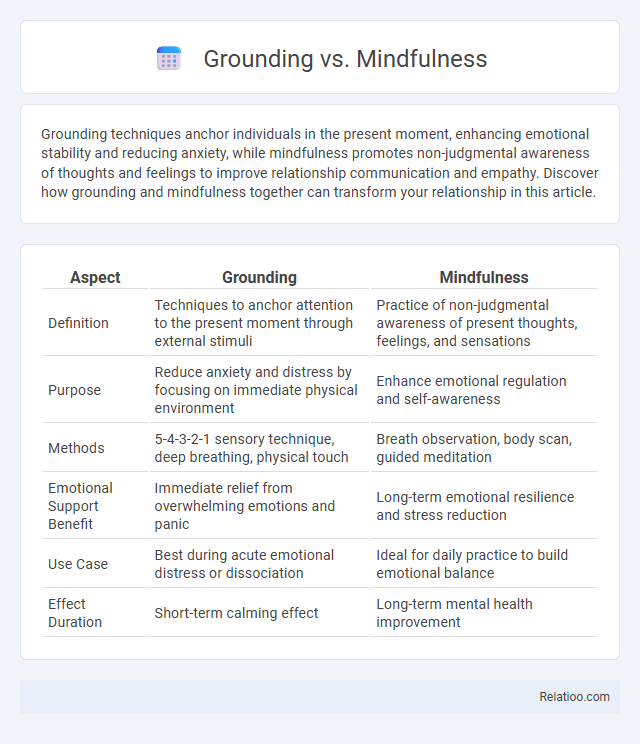Grounding techniques anchor individuals in the present moment, enhancing emotional stability and reducing anxiety, while mindfulness promotes non-judgmental awareness of thoughts and feelings to improve relationship communication and empathy. Discover how grounding and mindfulness together can transform your relationship in this article.
Table of Comparison
| Aspect | Grounding | Mindfulness |
|---|---|---|
| Definition | Techniques to anchor attention to the present moment through external stimuli | Practice of non-judgmental awareness of present thoughts, feelings, and sensations |
| Purpose | Reduce anxiety and distress by focusing on immediate physical environment | Enhance emotional regulation and self-awareness |
| Methods | 5-4-3-2-1 sensory technique, deep breathing, physical touch | Breath observation, body scan, guided meditation |
| Emotional Support Benefit | Immediate relief from overwhelming emotions and panic | Long-term emotional resilience and stress reduction |
| Use Case | Best during acute emotional distress or dissociation | Ideal for daily practice to build emotional balance |
| Effect Duration | Short-term calming effect | Long-term mental health improvement |
Understanding Grounding: Definition and Principles
Grounding is a therapeutic technique that helps individuals anchor themselves in the present moment by connecting with their physical surroundings and bodily sensations, reducing anxiety and dissociation. It involves sensory awareness and cognitive focus on immediate experiences, distinguishing it from mindfulness, which emphasizes non-judgmental awareness and acceptance of thoughts and emotions. Core principles of grounding include enhancing present-moment connection, fostering safety, and promoting emotional regulation through concrete, sensory-based exercises.
What Is Mindfulness? Key Concepts Explained
Mindfulness is the practice of maintaining focused awareness on the present moment while calmly acknowledging and accepting one's feelings, thoughts, and bodily sensations. Key concepts include intentional attention, non-judgmental observation, and present-moment awareness, which together help reduce stress and enhance emotional regulation. Unlike grounding techniques that anchor attention to physical sensations to manage anxiety, mindfulness cultivates a broader awareness of internal experiences and external environments.
Core Differences Between Grounding and Mindfulness
Grounding techniques help you reconnect with the present moment by using physical sensations to reduce anxiety and overwhelm, while mindfulness involves cultivating a non-judgmental awareness of thoughts, emotions, and surroundings. The core difference lies in grounding's emphasis on external sensory input to stabilize your mental state, whereas mindfulness encourages an internal observation and acceptance of your experience. Understanding this distinction can enhance your ability to manage stress and improve emotional regulation.
The Science Behind Grounding Techniques
Grounding techniques activate the parasympathetic nervous system, reducing cortisol levels and promoting physiological calm through sensory engagement with the present environment. Mindfulness involves sustained attention to present-moment experiences, enhancing prefrontal cortex function to regulate emotional responses and decrease amygdala activity. Neuroimaging studies reveal that grounding and mindfulness both modulate neural circuits related to stress and anxiety, but grounding's tactile focus offers immediate stabilization while mindfulness cultivates long-term cognitive control.
Mindfulness Practices: How They Work
Mindfulness practices center on maintaining focused awareness on the present moment, enhancing mental clarity and emotional regulation through sustained attention to sensations, thoughts, and feelings. Techniques such as mindful breathing and body scans activate the parasympathetic nervous system, reducing stress and promoting relaxation by shifting focus away from distressing stimuli. These practices cultivate non-judgmental awareness, improving cognitive flexibility and resilience by fostering acceptance and reducing reactive patterns in the brain.
Benefits of Grounding for Mental Health
Grounding techniques help individuals stay connected to the present moment by using physical sensations, which can reduce anxiety and promote emotional stability. Mindfulness emphasizes non-judgmental awareness of thoughts and feelings, fostering acceptance and stress reduction. Grounding benefits mental health by quickly alleviating feelings of overwhelm and dissociation, enhancing focus, and supporting emotional regulation during stressful situations.
Mindfulness for Stress Reduction and Wellbeing
Mindfulness involves focused awareness on the present moment, enhancing emotional regulation and reducing stress by promoting non-judgmental acceptance of thoughts and feelings. Grounding techniques reinforce connection to the physical environment, often used to manage anxiety by diverting attention from distressing thoughts to sensory experiences. For wellbeing, mindfulness offers sustained benefits through neuroplasticity, improving mental clarity and resilience more effectively than singular grounding methods.
Choosing the Right Practice: Grounding vs Mindfulness
Choosing the right practice between grounding and mindfulness depends on Your immediate needs and mental state; grounding techniques, such as sensory awareness or physical touch, anchor You to the present moment and reduce anxiety quickly. Mindfulness emphasizes non-judgmental awareness of thoughts and emotions over time, fostering long-term emotional resilience and clarity. Understanding the difference allows You to integrate grounding for acute stress relief and mindfulness for sustained mental well-being.
Integrating Grounding and Mindfulness in Daily Life
Integrating grounding and mindfulness in daily life enhances your emotional resilience and mental clarity by connecting present-moment awareness with sensory experiences. Grounding techniques, such as feeling your feet on the floor or holding an object, anchor you physically, while mindfulness cultivates a non-judgmental awareness of thoughts and feelings. Combining these practices daily supports stress reduction, improved focus, and a stronger connection to your body and mind.
Expert Tips for Effective Grounding and Mindfulness
Expert tips for effective grounding and mindfulness emphasize sensory engagement and present-moment awareness to reduce stress and enhance mental clarity. Grounding techniques often involve physical actions such as touching objects or deep breathing exercises, while mindfulness focuses on conscious attention to thoughts and feelings without judgment. Integrating both practices can improve emotional regulation and foster resilience by anchoring awareness in the here and now.

Infographic: Grounding vs Mindfulness
 relatioo.com
relatioo.com